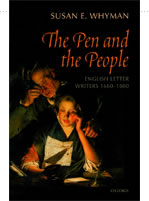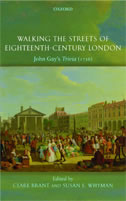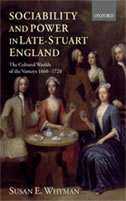Enlightenment and the Writing Self in Eighteenth-Century Britain
Review of Pen and the People writen by Betty A. Schellenberg
download PDF
Susan Whyman’s The Pen and the People, by contrast, highlights her research method- ology and makes the carefully cumulative structure of her argument explicit. She provides four appendices detailing the family archives, the individual writers, and the manuscript letters upon which her study is based, and explains her decision to focus on a few relatively in-depth case studies rather than create a “kaleidoscope of fragments” (234) drawn from all of the sixty-three family archives she originally analyzed. The book itself builds sequentially from an overview of the material conditions that enabled letter writing, to an examination of worker and middlingsort writers, and finally to a study of the development of “literary” elements in the letters of middling writers. Each segment is structured in terms of a chronological movement through the eighteenth century that traces “the rise of a popular epistolary tradition.” This tradition in turn parallels—indeed, enables—the first stages in the emergence of a middle-class culture defined by well-developed literacy and self-consciousness about personal identity and class affiliation.
Whyman presents her study as identifying and demonstrating the emergence of “a new cultural category: ‘epistolary literacy’” (9). A more developed level of expertise than the basic literacy of signing one’s name, “epistolary literacy” requires at a minimum a rudimentary knowledge of the postal service, of letter-writing conventions, and of basic composition, but can encompass a wide spectrum of competencies, including interpretive reading and the mastery of a range of “literary” skills such as quotation, storytelling, and original composition in a variety of genres. The category thus affords Whyman a framework within which to establish criteria for a qualitative evaluation of levels of literacy among individuals in her case studies. Even prior to her notion of epistolary literacy, a major contribution of Whyman’s work is in her discovery of the body of materials from which her case studies are drawn: extensive letter collections kept by people below the gentry rank, collections that prior to her research were simply assumed to be nonexistent. Assisted by the Access to Archives Database (A2A) of The National Archives, which provides online access to the catalogues of archives scattered throughout England and Wales, she discovered that the north of England in particular was characterized by a breadth of literacy that grew in parallel with the area’s accelerating industrial development. The extent of literacy in the region implies the widespread availability of informal education outside the registered schools that provided material evidence for prior research.
Whyman’s first chapter, “Creating the Letter,” provides an overview of the physical process of letter writing in the eighteenth century, the means by which children learned to write, and the instruction offered by copybooks and letter-writing manuals. While she downplays the influence of such manuals, emphasized in other recent work in the field, Whyman nevertheless underscores the importance of modeling: the children of both elite and merchant families were taught to write letters in imitation of their elders, of writing masters, and of literary figures. Parents in both social groups emphasized epistolary literacy as an essential social and business skill, increasingly important for sons and daughters alike. In the course of the century, the merchant class took the lead in developing a clear round hand and an informal style that became emblematic of English culture. This development was accompanied, as Whyman outlines in her second chapter, by innovation and expansion in the postal system through the long eighteenth century, resulting in an increasingly efficient network linking all corners of England. Once again, epistolary literacy entailed knowing how to use (or abuse) the Royal Mail, and Whyman shows through her subjects’ commentary how, “By 1800, a service created to censor mail had become a private necessity and a public right” extending across the nation and serving all strata of society (71).
Always engaging, The Pen and the People truly springs to life when Whyman presents her principal case studies—five consisting of farming and working families of the rural North (chapter 3), followed by three drawn from middling-sort families (chapter 4). The archive of the Soresbie family of farmers, for example, extending from the 1670s to the 1840s, is used to demonstrate that children were taught to write through copying and through the intermittent paid services of local instructors, that original composition emerged out of recombining copied phrases in personal copybooks, that individuals used letters to maintain their relations with distant family members and represent themselves to their social superiors through letters, and above all, that letter writing was prized by a family attempting to maintain and improve its status in a changing rural environment. Examining why, how, and to what effect such families used letters, then, Whyman finds a wide range of practical, social, and literary motivations, which support an understanding of literacy as both self-conscious and as heightening consciousness. This latter effect of letter writing is most fully explored in the chapter of middling-sort case studies, which presents a trio of Anglican, Quaker, and Congregationalist merchant families. Whyman uses extensive quotations from their letters to reveal the anxieties caused by their precarious social status and political disenfranchisement, as well as individuals’ negotiations of identity under the compet- ing pressures of religious belief, business demands, and gender roles.
In the third and final portion of her study, “From Letters to Literature,” Whyman leaves behind the north of England to focus on two generations of an upper- middling-sort family based in Buckinghamshire and then Bath: Jane Johnson, wife of Woolsey Johnson, a Church of England clergyman, and two of her children—Barbara, who remained unmarried andlived contentedly on a slender income from family legacies, and Robert, an army officer who married a wealthy widow, lived as a gentleman, and dabbled in science. Whyman shows throughout the book that letter writers’ refer- ences to reading materials are surprisingly common, even among those with no discernible formal education, but the project of these two chapters is more ambitious. Here she interweaves her analysis of the Johnsons’ correspondence with an account of the dominant literary culture of the day in order to show how highly developed epistolary literacy led to participation in that culture. Jane Johnson embeds in her letters educational materials specially designed for her children, dream visions, nature descriptions, and even a short story entitled “The History of Miss Clarissa of Bucking- hamshire.” Johnson’s use of such devices to analyze social problems of her day, Whyman argues plausibly, is a response to her favorite literary texts, which she quotes in her commonplace book. She focuses especially on the fictional models of Samuel Richardson, whose virtuous female characters use letters to work through moral and ethical dilemmas as well as to express themselves in highly individualized and literary styles. In her chapter on Jane Johnson’s children, Whyman traces a shift in their literary nature away from religious and moral reflection toward witty satire, the rhetoric of feeling, and critical commentary on recent publications. These changes, she argues, reflect the influences of sensibility, Scottish Enlightenment thought, and the review periodicals in the larger culture. (Into this chapter Whyman also introduces the children’s friend, Anna Riggs Miller, patron of famous poetry-vase contests at her Batheaston villa. Miller serves as an example of a middling-sort individual who first rises to prominence through public deployment of the fashionable literary activity of epistolary travel writing.)
Whyman initially presents the rise of epistolary literacy as paralleling Ian Watt’s rise of the novel: it depends on similar conditions—an interest in the quotidian lives of private people, a habit of self-examination, and the emergence of secular individualism. But ultimately, she suggests more provocatively that it was through repeated acts of epistolarity, requiring introspection and the expression of an identity both singly and through dialogue with a correspondent, that the characteristically middle-class habits of independent thought as well as conformity to such values as industry, honesty, reputation, and (for women) propriety were created. Moreover, the epistolary practices of people of the middling sort “influenced” (Whyman’s frequent term) the epistolary novel as developed by Samuel Richardson, as well as “the travel account, the critical review, and the sentimental novel” (215) in the latter half of the century. While Whyman’s discussions often imply a feedback loop—reading Clarissa, for example, inspired Jane Johnson to imitate her and to tell stories like hers, but Richardson himself was inspired to write by the feminine epistolary circles he became part of—causality at times remains vague. Did Richardson in fact participate in the sorts of epistolary exchange he represents in Clarissa before writing the novel? If not, what does it mean to say that Jane Johnson influenced his work? Indeed, at points Whyman’s claims appear highly provocative, suggesting that a number of the characteristic literary movements of the period were in fact the creations of relatively obscure, middling-sort readers struggling to work out the relation between their religious beliefs and their daily lives or developing a taste for the expression of feeling. Broadly speaking, I am sympathetic to the argument that a deeply embedded epistolary ethos might have shaped the literary movements of the day, but at the individual level it seems more likely that the majority of the writers presented here were imitating their reading material rather than influencing it.
In short, a more fully theorized approach to notions of identity and self- fashioning through epistolarity, and to the relationship between culture and the individual agent, might have been useful in this book. At times Whyman makes assertions that can only be speculative—for example, “Hitherto, [John Fawdington, Yorkshire bridle-maker] had had vague amorphous feelings. Letters gave him a space for the concrete expression of falling in love” (94). Even the definition of literacy that apparently “has underpinned this book”—Robert Pattison’s view of literacy as “a cultural process that demanded ‘consciousness of the uses of language and the mastery of skills to express them’” (110)—is not introduced until the end of the third chapter. Nevertheless, the argument that the act of elaborating ideas in letters took individuals “to a more complex level of literacy than spontaneous speech” (101) is intuitively convincing and certainly implied by the evidence Whyman presents so generously and analyzes so sensitively. The striking case studies of The Pen and the People, as well as the substantial archival body out of which they emerge, will certainly require a revision of the history of eighteenth-century literacy. In addition, for scholars of the period’s popular and literary print cultures, new and important questions have been raised about the role of the pen and the many humble people who wielded it in disseminating and shaping those cultures.
Betty a. Schellenberg is a professor of English at Simon Fraser University. Her most recent book is The Professionalization of Women Writers in Eighteenth-Century Britain (2005). She is currently editing a volume of the correspondence of Samuel Richardson and writing a study of the interface of manuscript cultures and print in the mid-eighteenth century.



